Share This Post
Yes — you can safely wind your automatic watch
In most cases, it is safe to manually wind an automatic watch. This is because most modern automatic watches have a built-in safety device called a “slip clutch.” This small component prevents the mainspring from becoming too tight.
Simply put: if the mainspring is fully wound, and you continue to turn the crown, the mainspring will slip out and not break.
Quick definitions:
- Mainspring: the coiled spring that stores energy inside a mechanical watch.
- Slip clutch (or slipping bridle): a mechanism that lets the mainspring slip when it’s fully wound so it doesn’t over-tension.
- Watch winder: a device that gently rotates an automatic watch to keep it wound when you’re not wearing it.
How to Manually Wind Your Automatic Watch?
Before you start — simple preparation
Take the watch off your wrist. From experience, winding while it’s on your wrist can put the crown at an odd angle and press on the stem. That can stress parts. It’s a small thing that’s easy to avoid.
Next, check if the watch is stopped or just low on power:
- Stopped? Wind it.
- Running but slow? Top it up.
Also, know the crown positions. Most crowns have two or three positions: neutral = pushed in, one click = date, two clicks = time. We’ll wind with the crown pushed in.
If your watch has a screw-down crown, unscrew it first. Rotate the crown counter‑clockwise a few turns until it feels loose and pops slightly outward — that’s the visual and tactile cue. Wind with the crown free. When finished, press the crown gently in, then screw it down clockwise until it seats and is finger-tight.
Don’t over-tighten. If the crown won’t unscrew or move, stop and check the manual or see a professional.
One more safety point: don’t wind with the crown pulled out, and avoid changing the date during the calendar-engaged period. That window varies by movement, but it’s roughly late night to early morning (often around 8pm–4am). Specific times vary by model—check your user manual.

The Proper Winding Technique
The proper winding technique
Here’s how I do it every time. It’s simple:
1. Hold the watch gently in one hand.
2. Use your thumb and forefinger to grip the crown.
3. Turn the crown slowly — steady, even turns.
4. Aim for about 20–40 turns as a practical rule of thumb — 30 is a common target. Exact turns vary by movement and how drained the spring is. Use resistance as your true guide.
5. Keep pressure gentle. You’ll feel light resistance as the spring stores energy.
What happens when you wind a watch?
You might hear a slight clicking sound. This is normal—the gears are working. Do not force it. Slow and steady rotation is key.
- Resistance should increase gradually.
- If you feel the vehicle suddenly stop or accelerate abruptly, stop immediately.
- If the crown starts to turn freely without increasing resistance, it may be due to a slipper clutch slipping—a common phenomenon in many modern automatic watches.
Regarding the direction of rotation: Many watches wind by rotating the crown clockwise with the dial facing up, but this is not the case for all watches.
The feel of the crown direction may vary depending on the movement. If you are unsure, consult the instruction manual or gently rotate the crown and feel the resistance.
The importance of the direction of rotation lies not in the direction itself, but in the gentle and continuous rotation.
Precautions when winding:
- Resistance will gradually increase during winding.
- If you feel a sudden stop, please stop winding. (This rarely happens with automatic watches.)
- If the resistance doesn’t change much when turning the crown, it may be due to clutch slippage—this is normal.
How much is enough?
How do you tell when to stop? Two easy cues:
- If resistance stops increasing, you’re near full.
- If the crown seems to turn freely with no extra resistance, the clutch is slipping. That’s safe.
When Should You Manually Wind Your Automatic Watch?
Your watch has stopped — jump-start it
If your automatic watch stops, manual winding is the fastest way to get it moving. A few dozen turns will usually do it. Wearing it will also charge the watch, but that takes longer. Want it working now? Wind it.
Before storing your watch
If you plan to store a watch for weeks or months, wind it and let it run briefly every few weeks. Why? The oils inside the movement can settle or pool if the gears sit still. Moving parts keeps lubricants spread evenly and prevents sticky issues later.
I do this with my vintage pieces — it’s like stretching before a run.
You don’t wear it daily
If you rotate watches, wind the one you’ll wear that day. It saves you from resetting calendars or moonphase complications. I have three automatics; a quick wind each week keeps them ready. It’s small effort for less hassle.
The truth about overwinding
Built-in safety: the slip clutch system
Many modern automatic movements have a sliding clutch mechanism in the mainspring barrel, making overwinding extremely unlikely.
When the mainspring reaches its limit, this mechanism slides along the barrel wall, preventing further increase in tension. Continuing to wind will only cause this mechanism to slip—a safety fail mechanism. Think of it like refueling an oil tank: once full, the pump clicks and stops.
However, there are exceptions. This can happen with very old watches, damaged clutches, or rare antique movements without a slipping clutch. Also, if you force the crown, yank on the stem, or use tools, you can cause damage. If in doubt, check the manufacturer’s manual or ask a watchmaker.
Rotor vs manual winding — what’s the difference
The core difference between automatic and manual winding mechanical watches lies in the energy input path and the mainspring’s safety mechanism.
Manual winding transmits energy directly through the crown; turning the crown drives the mainspring directly through the gear train—a clear, efficient, and controllable process. You can think of it as turning the key to an old-fashioned music box; each turn adds a little more energy to the mainspring.
Automatic winding, on the other hand, is an indirect process. It relies on the oscillation of a rotor (a oscillating weight) to drive a counter-rotating gear train, continuously replenishing the mainspring’s energy. Its efficiency depends on the movement’s design (unidirectional or bidirectional winding) and the wearer’s activity level.
Regarding safety mechanisms, these two methods handle the risk of overwinding differently.
Modern manual winding movements primarily prevent overwinding by limiting the number of winding turns and strengthening the structure. While this provides a certain margin of error, theoretically, overwinding still carries a risk.
Automatic winding movements typically employ more proactive overload protection mechanisms (such as a sliding clutch inside the mainspring barrel) to release excess internal energy after the mainspring is fully wound, fundamentally preventing overwinding caused by continuous daily wear.
Key Advice for Enthusiasts
- Trust your instincts: Ideally, winding should be smooth with a gradual increase in resistance. Whether manually or automatically winding, stop immediately if you experience a sudden change in resistance, unusual slippage, or difficulty turning.
- The instruction manual is the primary guide: When using any watch for the first time, always consult the official instruction manual for winding recommendations, number of turns, and precautions.
- Follow the maintenance schedule: Mechanical movements are precision instruments, and professional servicing is generally recommended every 3-5 years to ensure that core components such as the gear train and mainspring are in optimal condition.
How often should you wind your automatic watch?
Daily vs. occasional wearers
- Wear it daily: You likely don’t need to wind it. Your wrist motion keeps the rotor turning and the mainspring charged.
- Wear it occasionally: Wind it once before wearing. If you rotate watches, wind them weekly to keep oils moving.
Signs your watch could use some winding
Wind the watch if you notice:
- It stops running.
- Timekeeping becomes slow or jumpy.
- The power reserve indicator shows a low charge (if your watch has one).
Watch winder vs. manual winding
Your relationship with your watch determines whether a manual or automatic winding system is more suitable for you.
Manual winding: No cost, just a little time. If you only own one or two watches and wear them frequently, enjoying the pleasure of winding them, then manual winding is the ideal choice.
However, for the following situations, investing in a high-quality automatic watch winder will be a wiser and more worry-free choice:
1. If you are a watch enthusiast who owns multiple automatic watches and rotates them, an automatic winder is very practical.
It winds a watch by simulating the movement of wearing it when you are not wearing it. This way, when you want to switch watches, you don’t need to manually wind and adjust the time again; you can simply pick it up and put it on, saving time and effort.
2. For watches equipped with complicated functions such as annual calendars, perpetual calendars, and moon phases, once they stop, readjusting them can be very tedious and may even damage the movement due to improper operation.
Allowing these watches to run continuously on an automatic winding mechanism effectively prevents them from stopping due to power depletion, saving the hassle of readjustment.
From Manual to Automatic: An Upgrade to a Lifestyle
Manual winding has its own romantic and ritualistic charm, but if you own multiple watches, this ritual can become a burden.
It’s like you might enjoy hand-brewing coffee but still have a fully automatic coffee machine for busy mornings. Both meet different needs, and neither is inherently superior.
Choosing an automatic winder doesn’t mean giving up interaction with your watch, but rather choosing a more relaxed and efficient lifestyle. It allows technology to serve your hobby, letting you spend more time “appreciating” and “wearing” your watch, rather than “maintaining” it.
If this is the kind of experience you’re looking for, then choosing a high-quality automatic winding watch is undoubtedly a wise move.
In this regard, brands like Mozsly, with their high cost-performance ratio and stable, quiet operation, are gradually becoming the first choice for many users. It reliably handles daily maintenance, allowing you to pick up your beloved watch and wear it anytime, freeing you from the hassle of a stopped watch.
Key takeaways — manual winding made simple
- You can wind an automatic watch safely in most cases.
- Most automatics have a slip clutch that prevents overwinding, but exceptions exist.
- About 20–40 gentle clockwise turns is a practical rule of thumb — exact turns vary by movement (see References 2 and 3).
- Remove the watch from your wrist, make sure the crown is pushed in, and unscrew a screw-down crown before winding. Re-screw it afterward.
- Avoid winding or setting the date during the date-change window (roughly 9pm–3am).
- Wind occasionally if you store or rotate watches.
- Consider a Mozsly watch winder for hands-off convenience if you have multiple pieces.
Quick reference guide
- Remove watch from wrist.
- Crown in pushed-in (neutral) position.
- Unscrew screw-down crown first, if present.
- Turn crown slowly ≈30 times (rule of thumb).
- Stop when resistance stops rising or the crown slips.
- Re-seat and screw crown down after winding.
- Wind stored watches every few weeks or use a winder.
Your next steps
Try winding your watch now. Be gentle. You’ll be surprised how simple it is.
Related Post's
Featured Video
Provide an email subscription feature for users to sign up for updates.
Follow the world of watches and cigars for exclusive content!
By subscribing to our newsletter, you will be the first to receive notifications of our latest articles, popular posts and special events.







